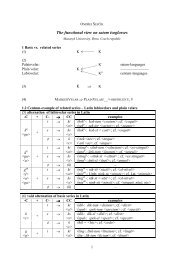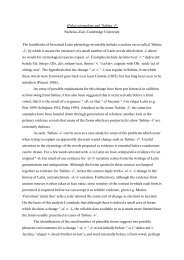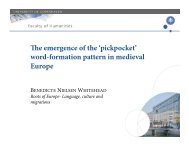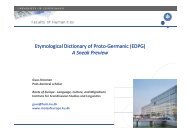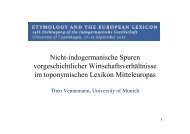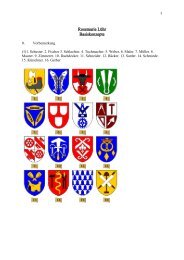Roots Deep in Heaven Indo-Iranian ritual concepts in a cross ...
Roots Deep in Heaven Indo-Iranian ritual concepts in a cross ...
Roots Deep in Heaven Indo-Iranian ritual concepts in a cross ...
Create successful ePaper yourself
Turn your PDF publications into a flip-book with our unique Google optimized e-Paper software.
Velizar Sadovski, <strong>Indo</strong>-<strong>Iranian</strong> <strong>ritual</strong> <strong>concepts</strong> <strong>in</strong> a <strong>cross</strong>-cultural perspective, 18.09.2012 7<br />
● Lat<strong>in</strong> evidence: Horace; Ovid (Loves 3.7.29; cf. GAGER, FARAONE ad loc.): wonders if a specialist<br />
sorcerer has “victimized (defixit) [him,] who has written his name <strong>in</strong> red wax and pierced it with a<br />
needle”.<br />
11.3. The Vedic notion of kr̥ tyā́ -. Dimensions of the concept (studied by HILLEBRANDT, HENRY, S.K.<br />
LAL, GOUDRIAAN):<br />
11.3.0.: Material: Counter-spell aga<strong>in</strong>st charmed clay effigies – Kauśika-Sūtra 39: esp. 7ff., 11ff.:, the<br />
Brahmán pierces it ‘with a hostile eye’ (sūtra 39,11) and shoots (an arrow) on places the effigy has<br />
wounded; he puts the effigy made of clay (12) on a hide, with the heels turned downwards (16), ano<strong>in</strong>ts<br />
it (18), b<strong>in</strong>ds it (19), pours water on it (14) and on places vulnerable by the effigy (28, 31) and plows on<br />
it with a plough drawn by black oxen (29).<br />
(A.) kr̥ tyā́ -, f. (esp., RVKh., AV., YV.):<br />
11.3.1. Abstract: ‘powerful magic hidden <strong>in</strong> an object’;<br />
11.3.2. Concrete: ‘magical object (buried <strong>in</strong>to the ground)’, esp. “voodoo doll” – Evidence from<br />
Yajurveda, from Kauśika-Sūtra and from the Atharvaveda-Paippalāda-Saṃhitā:<br />
● VSM 5.23 / VSK 5.6.2 út kr̥ tyā́ ṃ kirāmi ‘the kr̥ tyā I dig out’.<br />
● Kauś. 39,7ff.: kr̥ tyā́ - presented like a doll (CALAND, HENRY) or another object (GOUDRIAAN) to bury.<br />
Cf. also Egypt and Greece: The figur<strong>in</strong>e “does not to be a portrait, it suffices that it bears some very<br />
superficial resemblance to the identity” (M. MAUSS; F. GRAF).<br />
● GRIFFITHS ad AVP. 7,1: “the word<strong>in</strong>g of KauśS 39, sūtras 13 [...] and 14 [...] clearly implies an<br />
object of human (or animal) shape, and so do stanzas like ŚS 10.1.1, 10.1.24”.<br />
● On form<strong>in</strong>g human figures (puruṣākr̥ ti-) with the bones <strong>in</strong> of bury<strong>in</strong>g and commemorative <strong>ritual</strong>s, cf.<br />
LANMAN <strong>in</strong> WHITNEY – LANMAN 2,856–857, ad AVŚ. 18,3,25, on the father, represented by the prostrate<br />
figure of bones; and the quot. of Bāudhāyana-Pitr̥ medhasūtra 1,10, 5.7.10.13 (ed. CALAND, 15).<br />
11.4. <strong>Indo</strong>-<strong>Iranian</strong> evidence – Re-B<strong>in</strong>d<strong>in</strong>g disiecta membra. – AV 3,25,3–6:<br />
y plīhnaṃ śoṣáyati<br />
kmasyéṣuḥ súsaṃnatā /<br />
prācnapakṣā víyòṣā<br />
táyā vidhyāmi tvā hdí //3//<br />
śuc viddh víyòṣayā<br />
śúṣkāsya abhí sarpa mā /<br />
mdúr nímanyuḥ kévalī<br />
priyavādíny ánuvratā //4//<br />
jāmi tuvā janyā<br />
pári mātúr átho pitúḥ /<br />
yáthā máma krátāv áso<br />
máma cittám upyasi //5//<br />
víy àsyai mitrāvaruṇau<br />
hdáś cittniy asyatam /<br />
átha<strong>in</strong>ām akratúṃ ktv<br />
mámaivá kṇutaṃ váśe //6//<br />
3. The well-straightened arrow of love<br />
which dries the spleen [...],<br />
forward-w<strong>in</strong>ged, consum<strong>in</strong>g —<br />
therewith I pierce thee <strong>in</strong> the heart.<br />
4. Pierced with consum<strong>in</strong>g pa<strong>in</strong> [...], dry-mouthed,<br />
do thou come creep<strong>in</strong>g to me,<br />
gentle, with fury allayed, entirely [m<strong>in</strong>e],<br />
pleasant-spoken, submissive.<br />
5. I goad thee hither with a goad [...],<br />
away from mother, likewise from father,<br />
that thou mayest be <strong>in</strong> my power (krátu),<br />
mayest come unto my <strong>in</strong>tent.<br />
6. Do ye, O Mitra-and-Varuna, cast out<br />
the <strong>in</strong>tents from her heart;<br />
then, mak<strong>in</strong>g her powerless,<br />
make her [to be] <strong>in</strong> my own control (WL).<br />
(B.) valagá-, m.<br />
● TS. 1,3,2,1: idám aháṃ táṃ valagám úd vapāmi yáṃ naḥ samānó yám ásamāno nicakhā́ na ‘Here(and-now)<br />
I (am) get(t<strong>in</strong>g) out the Valaga which an equal, an unequal (person) has buried/dug <strong>in</strong> for us’.<br />
(C.) Kauśika <strong>ritual</strong> of bury<strong>in</strong>g a substitute of a female rival with AV mantras like AVP 1,15.<br />
11.5. Greek: ἀποστρέφω ‘to turn down’, generally used for the twist<strong>in</strong>g of hands and feet that are bound<br />
backwards (VERSNEL), a wide-spread topos <strong>in</strong> classical tabellae defixionum and esp. <strong>in</strong> ‘judicial<br />
curses’. – ἀποστρέφω as term<strong>in</strong>us technicus transferred on the tongue:<br />
SGD 99, ed. JORDAN (Demeter Malaphoros<br />
sanctuary at Gaggara, Sel<strong>in</strong>ous, early 5 th c. BC):<br />
Σελινόνντιος [κ]αὶ hα Σελινοντίο γλôσα<br />
ἀπεστραμέν’ ἐπ’ἀτλείαι ἐνγράφω τᾶι τένον<br />
VERSNEL, Fs.Burkert, 220:<br />
I ‘register’ Sel<strong>in</strong>untius [or the Sel<strong>in</strong>untian?] and the tongue of<br />
Sel<strong>in</strong>untius, so that it will be twisted and devoid of success.<br />
(b.) Veda:<br />
11.6. Kauś. 2,7[16],1-26: “To terrify enemy’s army, let it run away”: common nucleus and additional details:<br />
(3) somāṃśuṃ hariṇacarmaṇy utsīvya (3) He b<strong>in</strong>ds an (amulet) consist<strong>in</strong>g of Soma stalks, which he has sewn<br />
kṣatriyāya badhnāti<br />
<strong>in</strong>to a piece of gazelle leather, to a kṣatriya- around (his neck).<br />
(4) (pari vartmāni [6.67]) (<strong>in</strong>dro jayāti (4) Pronounc<strong>in</strong>g the songs AVŚ 6,67 or 6,98, the k<strong>in</strong>g goes (three times)<br />
[6.98]) iti rājā triḥ senāṃ pariyāti around his army (turn<strong>in</strong>g his right side to it, <strong>in</strong> order to make it<br />
<strong>in</strong>v<strong>in</strong>cible).<br />
(5) uktaḥ pūrvasya somāṃśuḥ (5) (Kauś. 2,7[16],3) deals with the charm – connected (only) with the first<br />
cited (song, i.e. 6,67) – with the (amulet) consist<strong>in</strong>g of Soma stalks.



